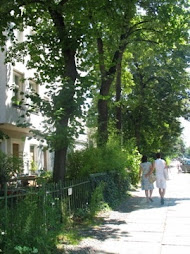
Wittenau Sanotorium, in the north of Berlin in a place now known as the Karl-Bonhoeffer-psychiatric unit, was a place which served as part of the Nazi 'Euthanasia' system. Thousands of patients were either killed there or were sent from there to be killed in other places.
In 1880 the 'lunatic and idiot institution' was built specifically for 'calm and agitated lunatics, agitated and unclean sick people, epileptic lunatics and bodily afflicted lunatics', together with a separate unit for 'idiotic children'. The start of the 20th century brought with it the foundation of an 'abstinence sanatorium' for alcoholics, morphine and and cocaine addicts, together with a welfare unit for mentally ill people.
As the 1920's arrived research was carried out into the patients in the units with regards to hereditary diseases, a research that was influenced by a social darwinism theory of 'racial hygiene' that would later be influential upon events after 1933.
The theory of 'racial hygiene' in Nazi Germany held that 'inferior' and 'burdening' people were producing a race of 'idiots', and that, coupled with their perceived higher birth rate, was seen as being bad for the German nation. 'Inferior people', so it was said, should be 'cut out' from society. Such a view led to the setting up of the 'law for the prevention of hereditary pro-creation', which led to the forced sterilisation of around 360,000 people between 1933 and 1945, which also happened in Wittenau.
The theory of 'racial hygiene' in Nazi Germany held that 'inferior' and 'burdening' people were producing a race of 'idiots', and that, coupled with their perceived higher birth rate, was seen as being bad for the German nation. 'Inferior people', so it was said, should be 'cut out' from society. Such a view led to the setting up of the 'law for the prevention of hereditary pro-creation', which led to the forced sterilisation of around 360,000 people between 1933 and 1945, which also happened in Wittenau.

The start of WWII brought a further development. Many old doctors from the unit joined the newly formed 'office for the extermination of those unworthy of life' on Tiergartenstraße 4, the so-named 'T4 action' (click on 'Berlin remembers victims of Nazi 'euthanasia' on the right for more details).
This legalised the 'mercy killing' of disabled, mentally ill and handicapped people. Around 200,000 were killed in total. Wittenau was part of this:
This legalised the 'mercy killing' of disabled, mentally ill and handicapped people. Around 200,000 were killed in total. Wittenau was part of this:
Wittenau served as an 'inbetween unit', which meant that those selected by other units to be killed were sent to Wittenau before being sent to other places, where they would be killed. It was done in this way to try to hide the purpose of their transporting. Around 3,000 Wittenau patients were killed in other places in this way.
Killing also took place in Wittenau itself. 4,941 people were killed through oral tablets or through hunger. Furthermore, around 5,000 children born with hereditary children were brought to Wittenau in order to receive a 'mercy killing'. Some were used for medical experiments.
Killing also took place in Wittenau itself. 4,941 people were killed through oral tablets or through hunger. Furthermore, around 5,000 children born with hereditary children were brought to Wittenau in order to receive a 'mercy killing'. Some were used for medical experiments.
As I said on the post about the persecution of the 'asocials' (click on 'persecution of 'asocials' remembered in Berlin' on the right for more details) it took decades before research was done into what forgotten themes. Eventually in the 1980's employees of the Karl-Bonhoeffer-sanatorium did their own research which led to the publication of the book 'Totgeschwiegen: 1933-1934 zur Geschichte der Wittenauer Heilstätten seit 1957 Karl-Bonhoeffer-Nervenklinik' and an exhibition is now to be seen there.
UPDATE: The exhibition has been redone and there's an internet site for it (in German): http://www.totgeschwiegen.info/index.html
Directions can be found on the site. It's easy to get there by S-Bahn or U-Bahn and then a short walk.
UPDATE: The exhibition has been redone and there's an internet site for it (in German): http://www.totgeschwiegen.info/index.html
Directions can be found on the site. It's easy to get there by S-Bahn or U-Bahn and then a short walk.

